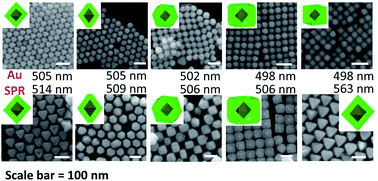Facile synthesis of Au–Pd core–shell nanocrystals with systematic shape evolution and tunable size for plasmonic property examination†
Abstract
A facile synthetic method has been developed for the formation of Au–Pd core–shell nanocrystals in aqueous solution in just 0.5–2 h at 50 °C with systematic shape evolution from cubic to truncated cubic, cuboctahedral, truncated octahedral, and octahedral structures using octahedral gold cores. By adjusting the amounts of H2PdCl4, ascorbic acid, and sometimes surfactants and gold cores added, the particle morphology can be finely tuned, and Pd shells with ultrathin thicknesses have been achieved. Gold cores of three different sizes (35, 45, and 74 nm in opposite corner distance) were used to obtain a full range of particle sizes and shapes for a most complete examination of their plasmonic properties. Visual observations made during particle synthesis reveal that Au–Pd cubes are formed at a faster rate than that for the growth of octahedra. For the smaller cubes, cuboctahedra, and truncated octahedra prepared using 35 and 45 nm gold cores, the surface plasmon resonance (SPR) absorption band from the gold cores can be seen only when the Pd shell thickness is just 1 nm at the thinnest points of the particles. For small-sized Au–Pd octahedra, this band is observable at a Pd shell thickness of around 5 nm. For larger Au–Pd nanocrystals synthesized from 74 nm gold cores, the Au SPR band is more recognizable for all particle shapes, although octahedra still exhibit the most obvious band. The band shifts slightly to the red going from cubes to octahedra. Simulation spectra have been performed, and they roughly match with the experimental spectra. Au–Pd octahedra with two different core sizes and shell thicknesses have been used for hydrogen sensing by comparing their UV-vis spectra before and after hydrogen incorporation forming PdH. The results show that the shell thickness is more important in producing a larger spectral red-shift after hydrogen absorption.


 Please wait while we load your content...
Please wait while we load your content...